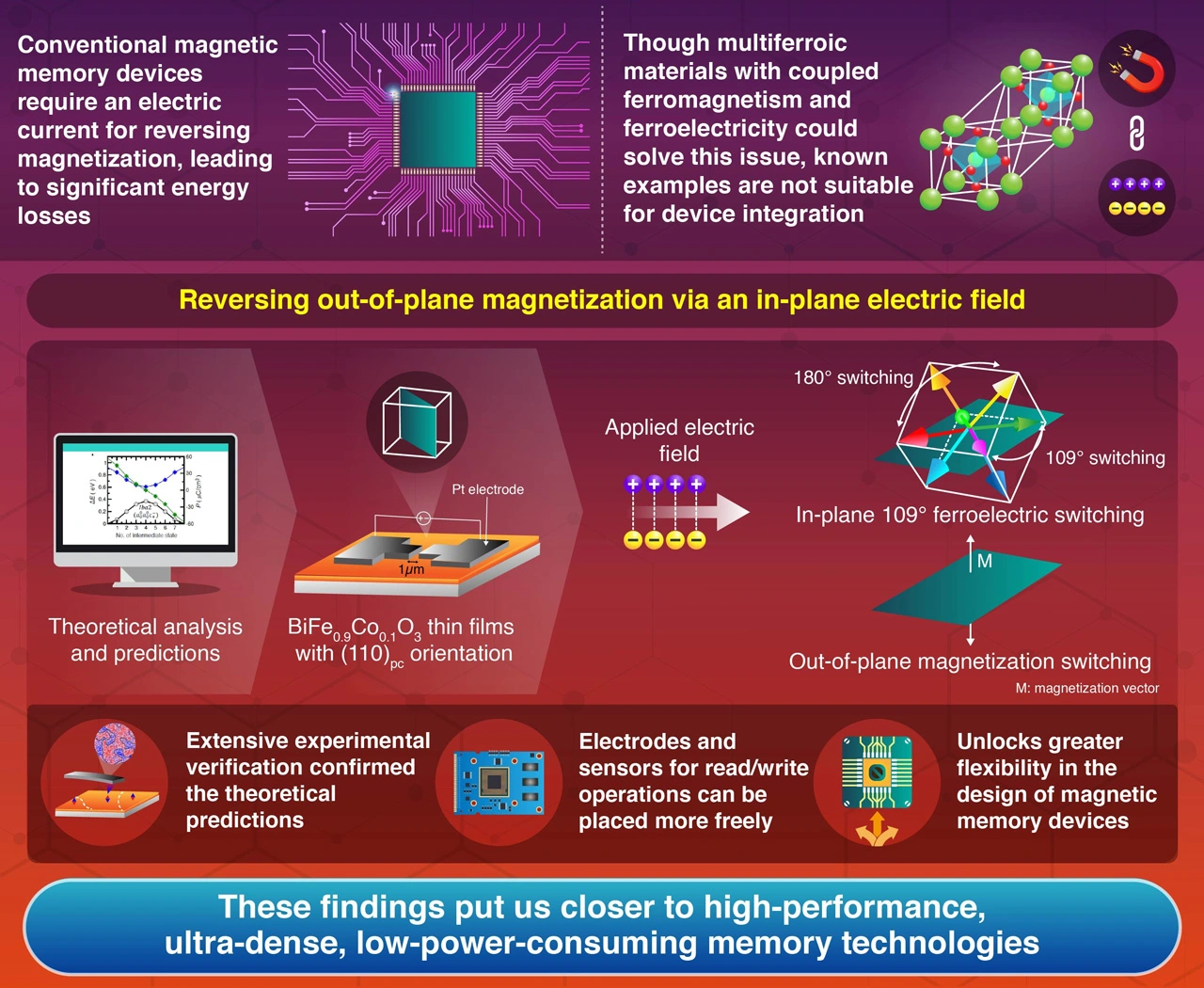Exploiting the full potential of multiferroic materials for magnetic memory devices
Researchers demonstrate a new strategy for magnetization reversal in multiferroic materials, opening pathways to more energy-efficient electronics
Magnetization components perpendicular to an applied electric field can be reversed efficiently in multiferroic materials, as reported by researchers from Institute of Science Tokyo. This challenges their previous finding that the electric field and magnetization reversal must align. Using BiFe0.9Co0.1O3 thin films with a specific crystallographic orientation, they demonstrated that a parallel electric field can induce perpendicular magnetization reversal, enabling more flexible designs of energy-efficient magnetic memory devices.
New Milestone in Multiferroic Materials for Magnetic Memories

Itoh et al. (2025) | Advanced Materials | DOI: 10.1002/adma.202419580
As the digital world demands greater data storage and faster access times, magnetic memory technologies have emerged as a promising frontier. However, conventional magnetic memory devices have an inherent limitation: They use electric currents to generate the magnetic fields necessary to reverse their stored magnetization, leading to energy losses in the form of heat. This inefficiency has pushed researchers to explore approaches that could further reduce power consumption in magnetic memories while maintaining or even enhancing their performance.
Multiferroic materials, which exhibit both ferroelectric and ferromagnetic properties, have long been considered potential game changers for next-generation memory devices. Ideally, magnetization in these materials would be coupled to electric fields rather than currents, providing a way to eliminate energy losses associated with magnetization reversal. Unfortunately, progress in this area has been limited by the assumption that the direction of an applied electric field must align with the magnetization reversal direction for effective device operation.
Against this backdrop, a research team led by Assistant Professor Kei Shigematsu and Specially Appointed Associate Professor Hena Das, in collaboration with graduate student Takuma Itoh and Professor Masaki Azuma from Institute of Science Tokyo, Japan, and Sumitomo Chemical Co. Ltd. has made a significant breakthrough in multiferroic materials. Their study, published online in Advanced Materials on April 28, 2025, demonstrated for the first time that magnetization components perpendicular to an applied electric field can be reversed in single-crystalline thin films of BiFe0.9Co0.1O3—a rare multiferroic material that exhibits coupled ferromagnetism and ferroelectricity at room temperature.
The research team achieved this breakthrough by growing BiFe0.9Co0.1O3 thin films in an unconventional crystallographic orientation. Using both theoretical calculations and experimental verification, they demonstrated that an electric field applied parallel to the film surface can induce magnetization reversal perpendicular to it. This phenomenon indicates that the angle of polarization switching plays a crucial role in determining the direction of magnetization reversal.
In their previous report, multiferroic memory designs assumed that electric fields and magnetization reversal must align along the same axis. By challenging this notion, this study opens new possibilities for device architectures in which electrodes for polarization switching and sensors for detecting magnetization reversal can be more flexibly positioned. “Such design flexibility could lead to more efficient utilization of the unique properties of BiFe0.9Co0.1O3, potentially enhancing device performance,” explains Shigematsu. “Moreover, in memory technology, higher integration density is crucial, and increased design flexibility directly supports that goal.”
Notably, higher integration densities in memory devices could ultimately lead to computers and electronic devices that consume significantly less power while offering improved performance and storage capacity. “We anticipate this breakthrough to significantly advance the development of next-generation magnetic memory devices, contributing to the realization of high-performance, ultra-dense memories,” remarks Shigematsu.
As global energy demands continue to rise and electronic devices become increasingly ubiquitous, breakthroughs that enhance space utilization and energy efficiency are vital. This research represents an important step toward realizing the full potential of multiferroic materials, helping us create more powerful yet sustainable digital technologies.
Reference
- Authors:
- Takuma Itoh1*, Kei Shigematsu1,2,3*, Hena Das1,2*, Peter Meisenheimer4, Kei Maeda1, Koomok Lee1, Mahir Manna5, Surya Prakash Reddy6, Sandhya Susarla6, Paul Stevenson7, Ramamoorthy Ramesh4,8,9,10, and Masaki Azuma1,2,3,11
*Corresponding authors - Title:
- Electric-Field-Driven Reversal of Ferromagnetism in (110)-Oriented, Single Phase, Multiferroic Co-Substituted BiFeO3 Thin Films
- Journal:
- Advanced Materials
- Affiliations:
- 1Materials and Structures Laboratory, Institute of Integrated Research, Institute of Science Tokyo, Japan
2Kanagawa Institute of Industrial Science and Technology, Japan
3Sumitomo Chemical Next-Generation Eco-Friendly Devices Collaborative Research Cluster, Institute of Science Tokyo, Japan
4Department of Materials Science and Engineering, University of California, USA
5Department of Physics, Arizona State University, USA
6School for Engineering of Matter, Transport and Energy, Arizona State University, USA
7Department of Physics, Northeastern University, USA
8Materials Sciences Division, Lawrence Berkeley National Laboratory, USA
9Department of Physics, University of California, USA
10Department of Materials Science and NanoEngineering, Department of Physics and Astronomy, Rice University, USA
11Research Center for Autonomous System Materialogy, Institute of Integrated Research, Institute of Science Tokyo, Japan
Related articles
Further Information
Assistant Professor Kei Shigematsu
Institute of Integrated Research, Institute of Science Tokyo
Contact
Public Relations Division, Institute of Science Tokyo
- Tel
- +81-3-5734-2975
- media@adm.isct.ac.jp